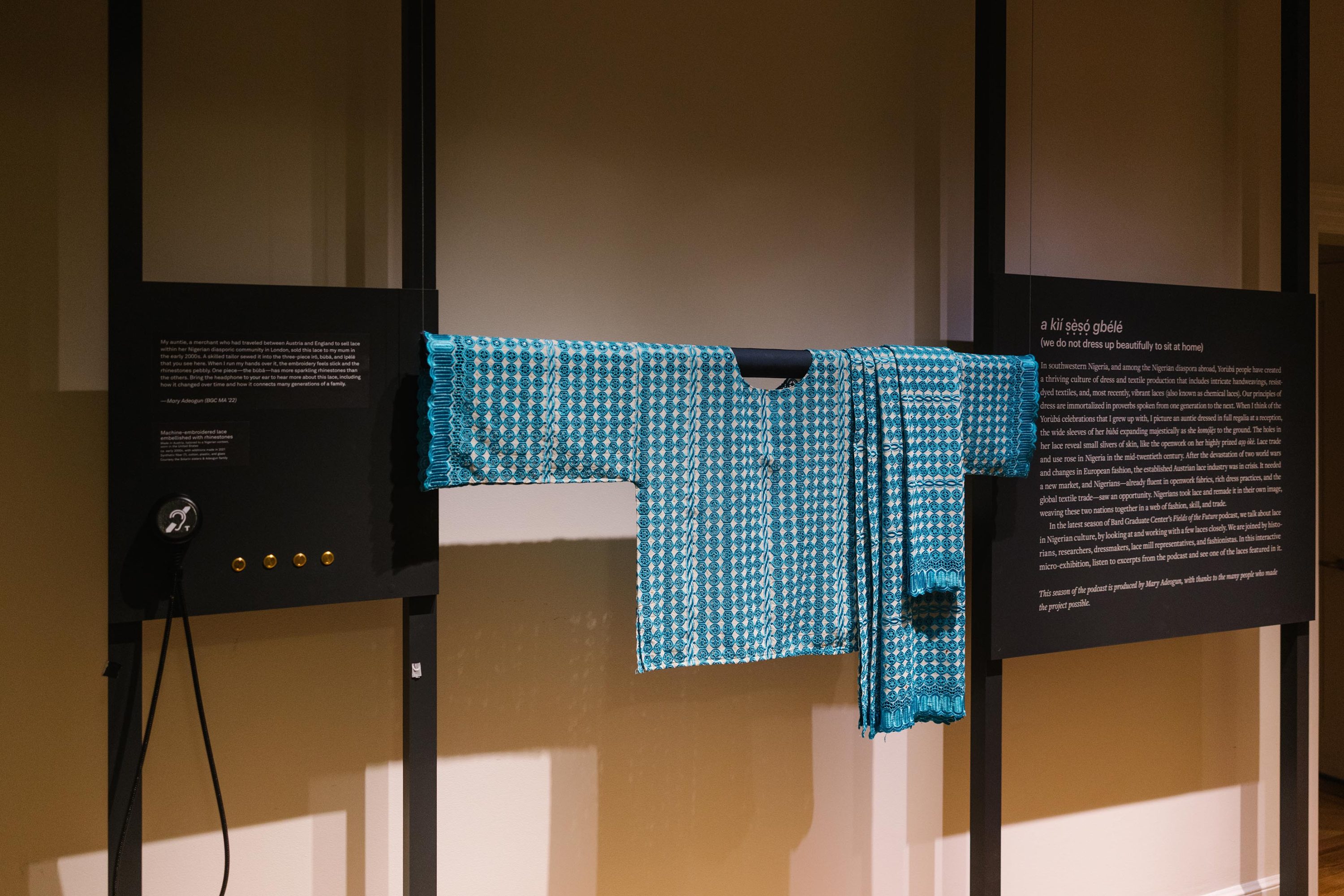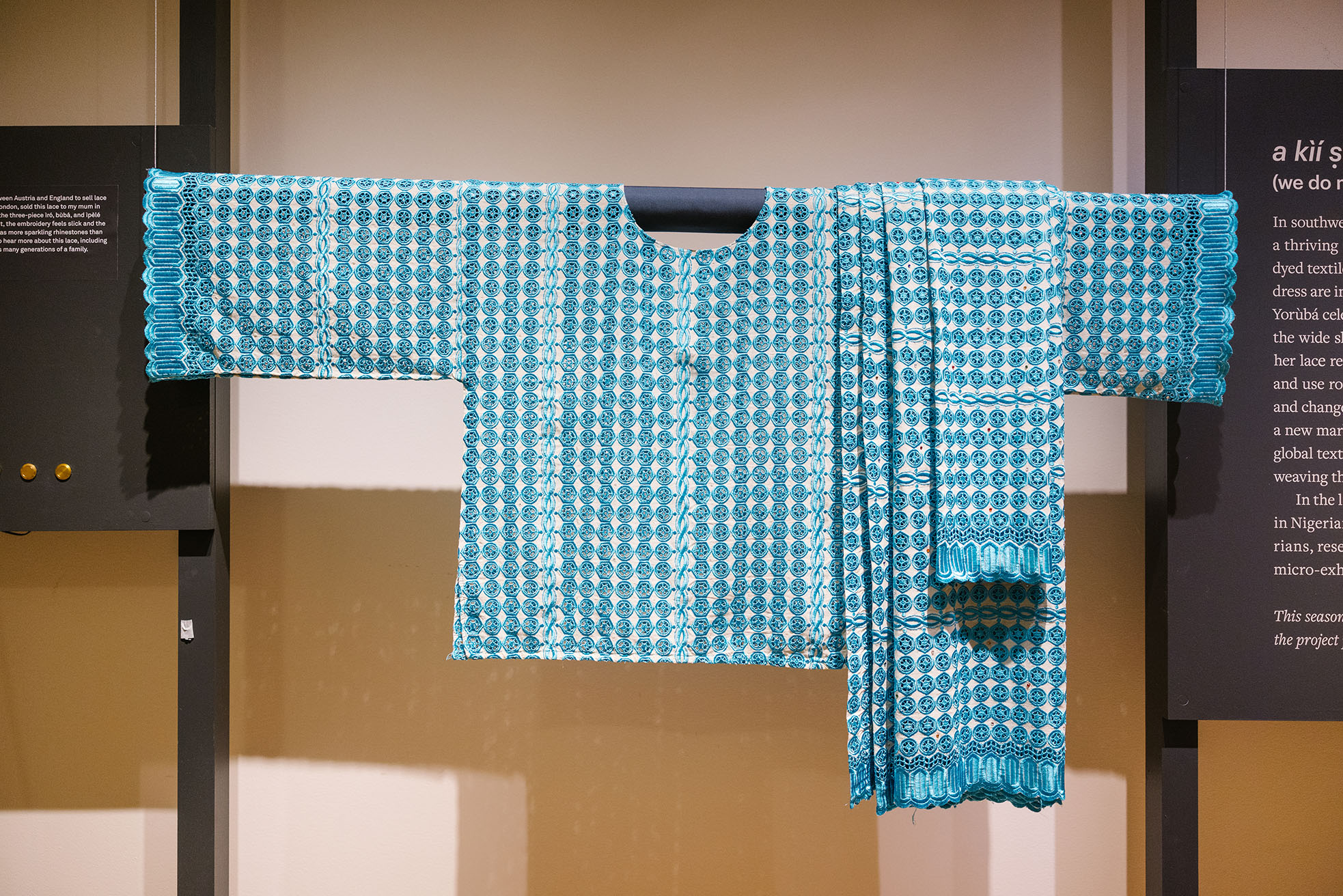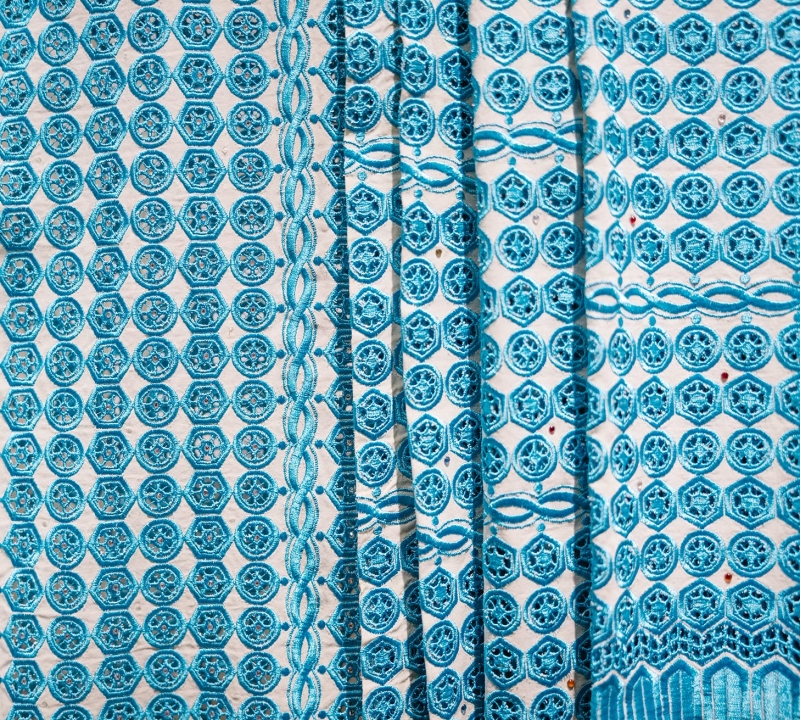a kìí ṣẹ̀ṣọ́ gbélé
(we do not dress up beautifully to sit at home)
“My auntie, a merchant who had traveled between Austria and England to sell lace within her Nigerian diasporic community in London, sold this lace to my mum in the early 2000s. A skilled tailor sewed it into the three-piece ìró, bùbá, and ìpèlé that you see here. When I run my hands over it, the embroidery feels slick and the rhinestones pebbly. One piece—the bùbá—has more sparkling rhinestones than the others. Listen to this season of the podcast to hear more about this lace, including how it changed over time and how it connects many generations of a family.”
mary adeogun (BGC MA ’22)

“My auntie, a merchant who had traveled between Austria and England to sell lace within her Nigerian diasporic community in London, sold this lace to my mum in the early 2000s. A skilled tailor sewed it into the three-piece ìró, bùbá, and ìpèlé that you see here. When I run my hands over it, the embroidery feels slick and the rhinestones pebbly. One piece—the bùbá—has more sparkling rhinestones than the others. Listen to this season of the podcast to hear more about this lace, including how it changed over time and how it connects many generations of a family.”
mary adeogun (BGC MA ’22)

In southwestern Nigeria, and among the Nigerian diaspora abroad, Yorùbá people have created a thriving culture of dress and textile production that includes intricate hand weavings, resist-dyed textiles, and, most recently, vibrant laces (also known as chemical laces). Our principles of dress are immortalized in proverbs spoken from one generation to the next. When I think of the Yorùbá celebrations that I grew up with, I picture an auntie dressed in full regalia at a reception, the wide sleeves of her bùbá expanding majestically as she komọ́lẹ̀s to the ground. The holes in her lace reveal small slivers of skin, like the openwork on her highly prized aṣọ òkè. Lace trade and use rose in Nigeria in the mid-twentieth century. After the devastation of two world wars and changes in European fashion, the established Austrian lace industry was in crisis. It needed a new market, and Nigerians—already fluent in openwork fabrics, rich dress practices, and the global textile trade—saw an opportunity. Nigerians took lace and remade it in their own image, weaving these two nations together in a web of fashion, skill, and trade.
In southwestern Nigeria, and among the Nigerian diaspora abroad, Yorùbá people have created a thriving culture of dress and textile production that includes intricate hand weavings, resist-dyed textiles, and, most recently, vibrant laces (also known as chemical laces). Our principles of dress are immortalized in proverbs spoken from one generation to the next. When I think of the Yorùbá celebrations that I grew up with, I picture an auntie dressed in full regalia at a reception, the wide sleeves of her bùbá expanding majestically as she komọ́lẹ̀s to the ground. The holes in her lace reveal small slivers of skin, like the openwork on her highly prized aṣọ òkè. Lace trade and use rose in Nigeria in the mid-twentieth century. After the devastation of two world wars and changes in European fashion, the established Austrian lace industry was in crisis. It needed a new market, and Nigerians—already fluent in openwork fabrics, rich dress practices, and the global textile trade—saw an opportunity. Nigerians took lace and remade it in their own image, weaving these two nations together in a web of fashion, skill, and trade.

Fields of the Future
Season 3: there is nothing new about lace

In the latest season of Bard Graduate Center’s Fields of the Future podcast, we talk about lace in Nigerian culture, by looking at and working with a few laces closely. We are joined by historians, researchers, dressmakers, lace mill representatives, and fashionistas.
This season of the podcast is produced by mary adeogun (BGC MA ‘22), with thanks to the many people who made the project possible.
what makes a good lace?, part 1
In this episode, two and a half generations of a Nigerian diasporic family sit around the table to talk about some of our favorite laces. We bounce from “classics,” like Swiss voile and French lace, to the latest trends, like sequins and beading on netting, or tulle. Come sit with us as we reflect on how tastes have changed, gist about our likes (and dislikes), and wonder where things might be headed.
lace, remade in our image
Think of the fabrics around you growing up—is there a familiar stack of textiles, patterns, or garments? How did they get there? In this episode, we talk about how laces made in Austria landed thousands of miles away in the wardrobes of Nigerians, and the things that happened along the way as Nigerians remade these laces in their own image. It’s a story of evolving tastes, enduring culture, trade policies, industry crises, and more.
aṣọ ẹbí, the family cloth
As soon one hears that Baba so-and-so is celebrating his 70th, the next question might be, “Is there aṣọ ẹbí for the event?” In this episode, we talk about aṣọ ẹbí, our community practice that fuels the buying, selling, and wearing of textiles for celebrations in Nigerian communities.

